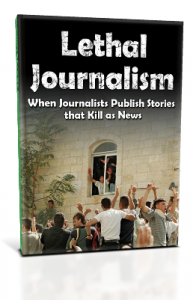
News analysis that examines Durah Journalism:
Latest (in French):
- Veronique Chemla, “Quand la « rue arabe » pro-palestinienne défile…“
Jenin Refugee Camp: April 2002. Perhaps the first major wave of DurahJournalism came with the coverage of Operation Defensive Shield’s siege of the Jenin Refugee camp, ground zero for the suicide bombers that had plagued Israel for two years before they responded in force.
- Tom Gross, “Jeningrad: What the British Media Said,” National Review, 13.5.02
- Adam Levick, Ten Years Since Something That Never Happened , (Harry’s Place)
- Hadar Sela, Another lethal narrative on the BBC website (BBC Watch)
Guild Mentality: June 2008: A particularly revealing episode of the corporatism and self-protectiveness of the media in refusing to reconsider coverage that, no matter how damaging, might damage the framing of the conflict between Israel and her neighbors came in response to Philippe Karsenty’s victory in the Appeals court in 2008.
- Ivan Rioufol, “Les médias, pouvoir intouchable,” Le Figaro, 13.6.08
- John Rosenthal, When it Comes to Al Durah, Journalists Are Against Free Speech, PJMedia 20.6.08
- Anne-Elisabeth Moutet, “L’affaire Enderlin: Being a French journalist means never having to say you’re sorry” Weekly Standard, 7.7.08
Snipers Murdering Innocent Children. Perhaps the single most grotesque meme in the arsenal of lethal journalism is the claim that Israeli soldiers deliberately murder Palestinian children.
The Double Standard in Coverage. The bottom line of all DurahJournalism is the double (or quadruple) standard in treating similar phenomena when different actors are at play. The contrast illustrates the way in which journalists stack the deck in favor of other Western armies and save their moral outrage for the IDF and their empathy for its victims.
